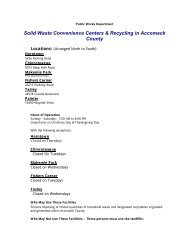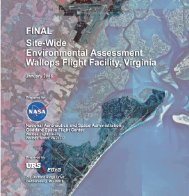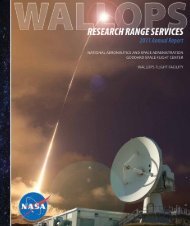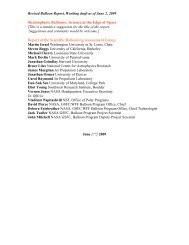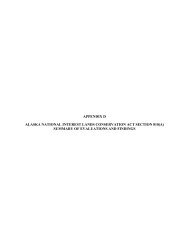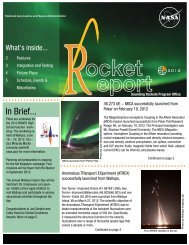WFF Frequency Utilization Management Handbook - Wallops Flight ...
WFF Frequency Utilization Management Handbook - Wallops Flight ...
WFF Frequency Utilization Management Handbook - Wallops Flight ...
Create successful ePaper yourself
Turn your PDF publications into a flip-book with our unique Google optimized e-Paper software.
800-HDBK-0001B<br />
8 of 31<br />
the requesting organization when the decision is made to proceed with a formal request to<br />
NTIA or FCC for frequency assignment.<br />
2. In a case where the selected frequency is in conflict with another organization’s best<br />
interests, it is probable that organization’s NTIA or FCC representative will oppose the<br />
assignment at the NTIA or FCC level. It can also be anticipated that there will be severe<br />
scheduling difficulties when brought into operational use at <strong>Wallops</strong>.<br />
3. After receipt of a NTIA or FCC assignment, the organization can request scheduling of<br />
operations at <strong>Wallops</strong> through the <strong>WFF</strong> Test Director. The Test Director will consider all<br />
current operational constraints when scheduling these operations.<br />
Figure 2 depicts the major steps necessary to obtain authorization for radiation of frequencies<br />
that are selected at a local organization level.<br />
5.3 ADMINISTRATIVE CONSIDERATIONS<br />
A file number will be assigned to each frequency action form (appendixes B through E) to relate<br />
authorizations to supporting recommendations and technical data. An equipment code will be<br />
assigned to each frequency for the associated transmitting/receiving equipment. This code will<br />
appear on the authorization form (Appendix E) and in the database maintained at <strong>Wallops</strong>.<br />
RFI and safety related factors are given prime consideration in authorizing frequencies to be<br />
radiated at <strong>Wallops</strong>. Changes in authorized RFI and safety parameters will require the frequency<br />
utilization request be resubmitted for evaluation and authorization.<br />
Regardless of planning, there will be cases when it will be necessary to radiate without going<br />
through normal time consuming approval procedures to allow an operation to proceed as<br />
scheduled. These cases occur when an operation is imminent or in progress, when it cannot<br />
reasonably be delayed, and when it has been determined that the required authorizations are not<br />
available. This situation usually results from real-time changes in such things as frequencies,<br />
systems, or participants or from incomplete planning. There are other infrequent cases when it is<br />
expedient to radiate without going through the normal approval procedure because the magnitude<br />
of the effort outweighs the need for the procedure. This is justified only when the requested<br />
radiation period is very short and the potential for RFI or safety problems is insignificant. Upon<br />
receipt of data related to the required frequencies, the WFUMWG Chair will make an assessment<br />
of RFI or safety considerations and will consult in real time with the appropriate Safety<br />
personnel and users of potentially conflicting systems. If warranted, he/she will give temporary<br />
unwritten authorization to use the required frequency.<br />
The WFUMWG Chair is authorized to issue temporary unwritten authorization to radiate for the<br />
purpose of making radiation hazard measurements to determine radiation hazard restrictions.<br />
This will be done under direction of Safety personnel with consideration of RFI impact on<br />
systems in use at <strong>Wallops</strong>.<br />
The WFUMWG Chair is authorized to extend the dates of frequency authorizations for<br />
reasonable periods when changes in projects/operations require additional time or rescheduling<br />
Check the <strong>Wallops</strong> Documentation Web site at<br />
http://www.wff.nasa.gov to verify this is the correct version prior to use.





